| Madeira to Bermuda | |
| After nearly a week on Madeira, Bob and I departed the Marina at Calheta heading for Bermuda, over 2400 nm to the West. | |
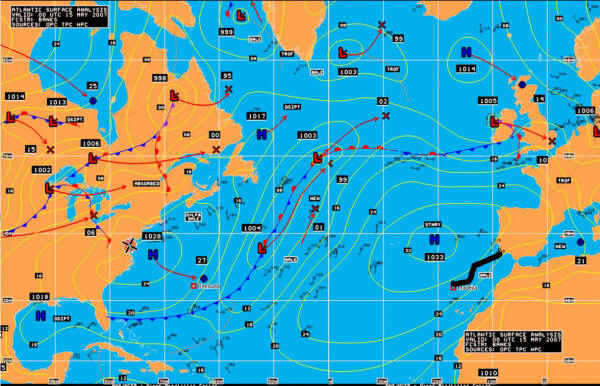 Chart by NOAA |
We had delayed our departure for a few days waiting for the high pressure ridge to settle in to the NW of Madeira. The NOAA weather chart for May 15 at 00z on the left shows the high pressure ridge centered to the NW of Madeira, with a gale blowing off the coast of Africa. This gale was several hundred miles to the east of Madeira, but a near gale blowing in the vicinity of the island. |
|
|
|
Photo by Bob Calt |
Once
we cleared Ponta do Pargo on the west end of Madeira we were out of the lee
of the island and sailing in 25-30 kts of wind out of the NE and the
seas built to more than 8'. This wind direction allow us to initially sail directly on the rhumb line to Bermuda with the winds on our starboard quarter. |
|
Photo by Bob Calt |
For the next week we never saw winds less than 20 kts. Most of the time the wind was around 30 with gusts higher. |
|
Photo by Bob Calt |
Fortunately
the wind remained on the quarter and we sailed close to the rhumb line
toward Bermuda. We were sailing in fair weather with only occasional
rain showers (mostly at night). However the seas were large enough that
foul weather gear was necessary to stay dry as we took a lot of water on
deck and in the cockpit. The air temperature was also surprisingly cool during this leg of the voyage. I had expected to need a sweater or more at night, but not during a bright sunny day. Those strong NE winds were pulling a lot of cold air from Northern Europe down to our area of the ocean.
|
| Below is a short video clip from the first week of our sail from Madeira to Bermuda. Bob demonstrates our use of safety harnesses when in the cockpit. | |
|
Photo by Bob Calt |
For the first week we remained on starboard tack, sailing close to the rhumb line. |
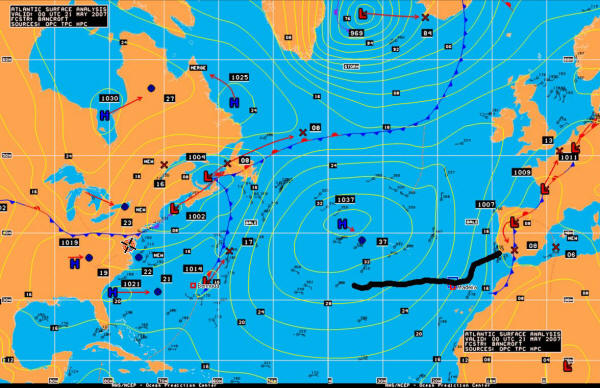 Chart by NOAA |
During the week the high pressure remained centered over the central N. Atlantic. By June 21 the winds became more easterly so we jybed to port and headed south of the rhumb line to keep the wind and seas on the quarter and to remain within the 20 kt wind field. |
|
If this chafing continued I would eventually have to replace one or both of the control lines. That would not be easy while hanging over the transom in 8' seas. Fortunately the existing lines were overly long and I had sufficient additional length to fight off the chafe. |
|
|
Photo by Bob Calt |
By the end of the first week the wind had dropped to 20 - 25 kts and the seas were down to about 6' or less. This eased the stress on the control lines and there was minimal chafe the rest of the way to Bermuda. |
|
When Bob came on board he vowed to improve the score on this trans-Atlantic voyage. Good to his word we had a 300% improvement - we caught three fish this time. I think that works out to one fish for every 10 days of fishing. Nobody can claim that we were decimating the ocean fish population. The first fish we caught was a Mahi-Mahi, similar in size to the one we caught in 2005. When we caught this fish we were still in 30 kts of wind and 10' seas. Neither one of us was up to cleaning a fish in those conditions, so we tossed the dead fish overboard. About a week later Bob hooked into a doubler - two fish on line at the same time. |
|
|
These fish appear to be the more common White Scabbard and smaller than the fish normally sold in the fish markets. Bob and I were looking forward to a dinner of Scabbard Fish as we had several excellent meals of this fish at restaurants in Lagos and on Madeira. Unfortunately there appears to be a special technique required to clean these fish and they defeated Bob's best efforts. These two fish ended up as bait on our lines, a role in which they did not excel in as we caught no more fish on this trip. You can see a close up of the Scabbard Fish in the photo above. The fish look like eels with barracuda heads. Not the prettiest fish in the ocean, for sure. |
|
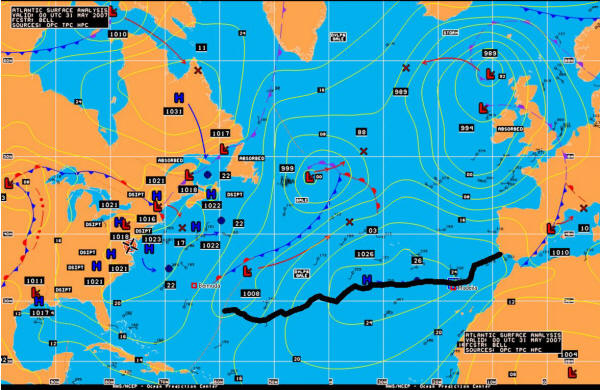 Chart by NOAA |
By
May 31 the high pressure ridge had moved to the east and we were sailing
into a low pressure trough that had been lying off the east coast of the
US since we departed Madeira. This trough had been the source of a
number of low pressure systems that had formed in the vicinity of the
Bahamas and Cuba and had been moving to the NE. By this time we had sailed to nearly 50 W Lon and passed through the semi-stationary frontal zone that extended from the complex low pressure system off the Canadian Maritimes. |
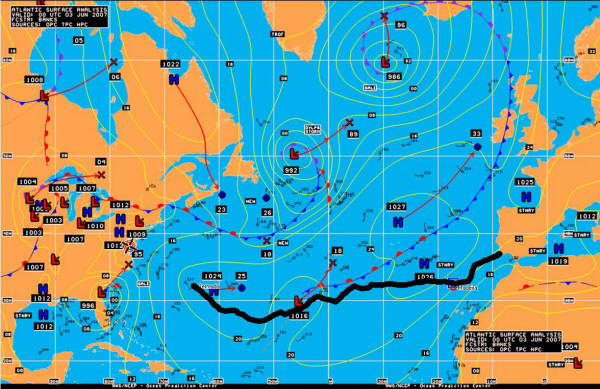 Chart by NOAA |
For
the next several days we sailed a generally WSW course as we watched the
continuing development of these low pressure systems to our west. On
the advice of Herb Helgenberg we stayed to the south of 30 N Lat to stay
out of the wind field of these lows. The last of these lows briefly became TS Barry as it moved along the SE coast of the US. That storm provided us with moderate SW winds for our final run NW to Bermuda. |
|
|
|
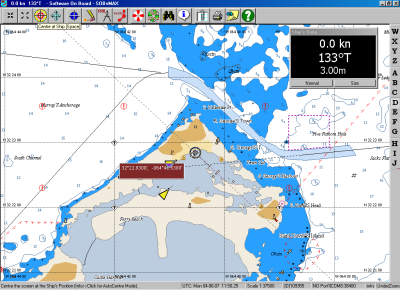 On
June 4, 2007 Sarah entered the harbor at St. Georges, Bermuda and tied
to the customs dock on Ordnance Island for customs and immigration
processing into Bermuda. On
June 4, 2007 Sarah entered the harbor at St. Georges, Bermuda and tied
to the customs dock on Ordnance Island for customs and immigration
processing into Bermuda. |
|
| Here is link to the log of the Madeira to Bermuda voyage in a MS Excel Workbook. | |